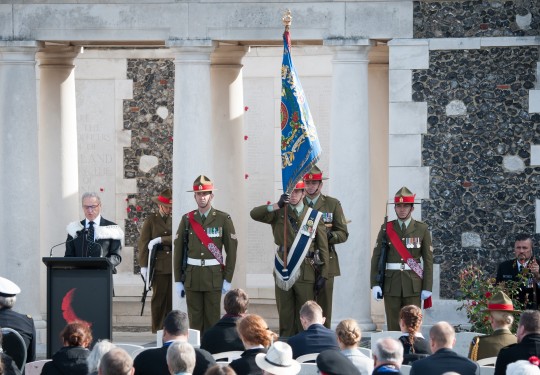Search begins for families of recently identified First World War casualties
The final resting place of two machine gunners named Thomas who died on New Zealand’s ‘blackest day’ of the First World War can now be identified thanks to new research.
10 October, 2025
But now the search begins for the two men’s descendants.
Sergeant Thomas Smith, aged 31, and Corporal Thomas Nigel McFarland, aged 27, of the New Zealand Machine Gun Corps (NZMG), were killed on 12 October 1917 during the Battle of Passchendaele in Belgium when the New Zealand Division and their allies launched a disastrous attack on Bellevue Spur.
At least 843 New Zealanders were killed in action on that day – the highest number of Kiwis to die in battle on a single day - with many thousands more wounded.
In the aftermath of the fighting, many New Zealand families mourned multiple losses with at least five sets of brothers recorded amongst the 1,176 names engraved on the Memorial to the Missing at Tyne Cot Cemetery in Belgium.
Corporal McFarland was one of nine siblings and his brother, Robert, also served in, and survived, the First World War.
New research from independent, volunteer researchers conducted in 2019, along with further information from the Commonwealth War Graves Commission and New Zealand Defence Force (NZDF) historians has revealed the final resting place of the two men.
NZDF historian John Crawford said the archival evidence supporting the identification of the graves was “clear and compelling”.
“To identify the two men, our team were able to use evidence held at Archives New Zealand, which details the known positions of the New Zealand Machine Gun Companies, and the rank and corps information recorded in the archival material held by the Commonwealth War Graves Commission,” Mr Crawford said.
“We know that, in the case of Sergeant Smith, he is the only candidate whose rank and corps matches the particulars of the individual recorded in the unknown grave at Tyne Cot Cemetery in Belgium, and there are no other missing New Zealand servicemen of this rank and corps.”
His remains were recovered close to the position of 5th NZMG Company, which he was a member of.
Corporal McFarland was the only candidate matching the particulars of an unknown grave in Passchendaele New British Cemetery.
While his remains were not located near the guns of his Company (1st NZMG Company), they were found near Company Headquarters and the 3rd Rifle Brigade headquarters, to which this Company was attached. This proximity and the nature of the fighting at Passchendaele, combined with the rank and corps insignia recorded as found with the remains in the years immediately following the war, is considered sufficient evidence to confirm the identification of this previously unknown grave.
“We are grateful for the volunteer researchers submitting the information which led to this identification and means we can now share the new research with descendants if they make themselves known to us.”
The men’s gravesites will now be officially acknowledged through the marking of their final resting place with new headstones bearing their names and Mr Crawford said it was hoped family members would be made aware beforehand.
Corporal McFarland, a bank clerk with the Bank of New South Wales in Lawrence, South Otago, enlisted on 14 August 1914, ten days after the British declaration of war upon Germany.
Newspaper coverage reports from the time said he was wounded in action in Gallipoli and the Somme offensive.
Death notices and obituaries flooded New Zealand’s publications following Passchendaele and Corporal McFarland is among the notifications.
In a small obituary inserted by “loving aunt and cousins” is a Thomas Campbell quote – “To live in the hearts of those we love is not to die”, while the committee of the Lawrence Lawn Tennis Club reported that he was a “very enthusiastic player and his genial presence will be greatly missed”.
Sergeant Smith, born 1885 in Portsmouth, England, had considerable military experience when he joined, including 18 months with 3rd Hampshire Regiment and eight years as a Seaman Torpedoman with the Royal Navy.
At the time of enlistment in New Zealand on 29 November 1915, he was a merchant seaman with the Canterbury Steamship Company and living in a boarding house in Lyttelton, Canterbury.
His attestation papers noted his forearm tattoos – not unusual for a sailor – with his assessor marking him as “a very suitable man”.
Relatives of either of these men are encouraged to email historyenquiries@nzdf.mil.nz
